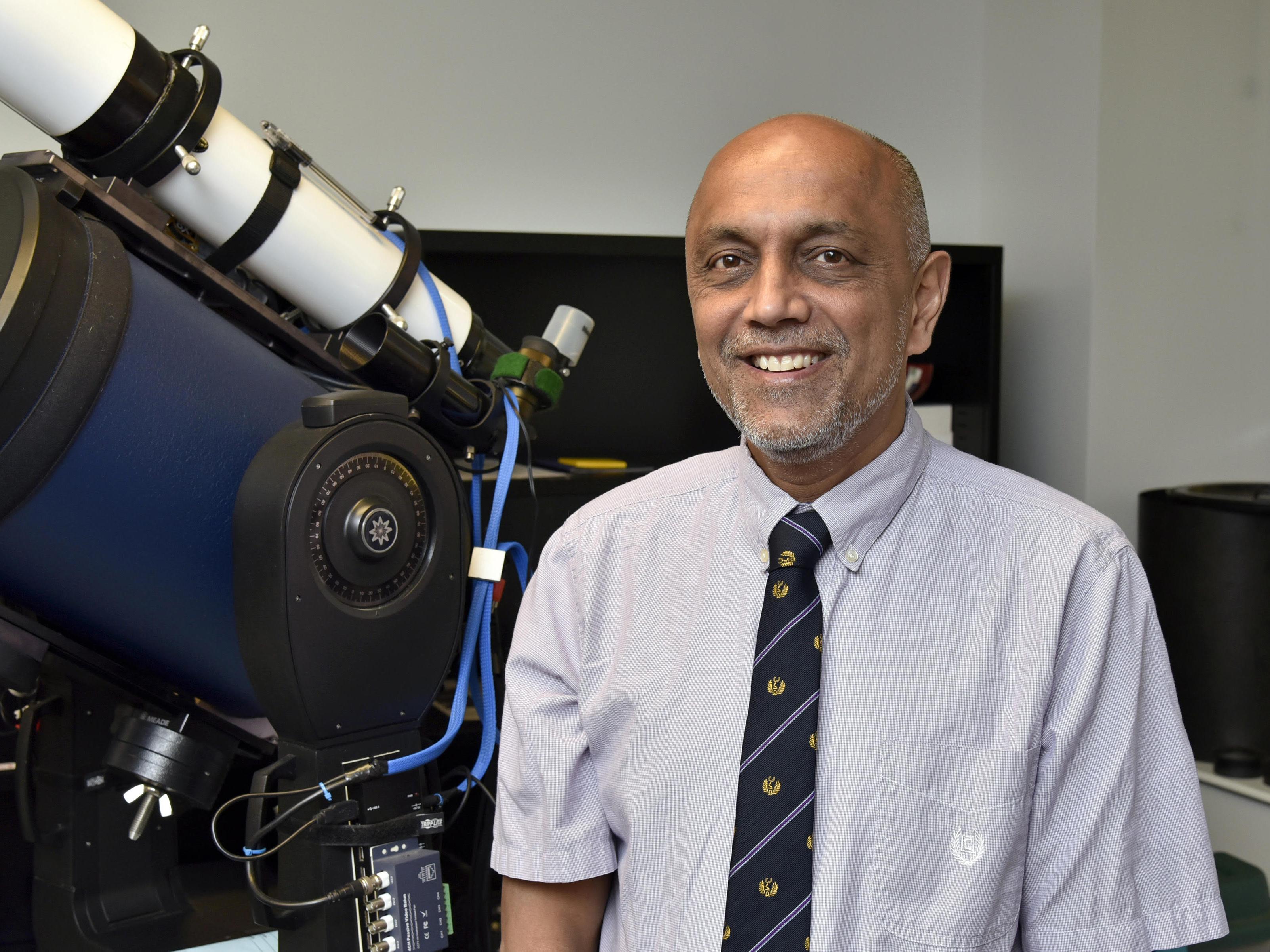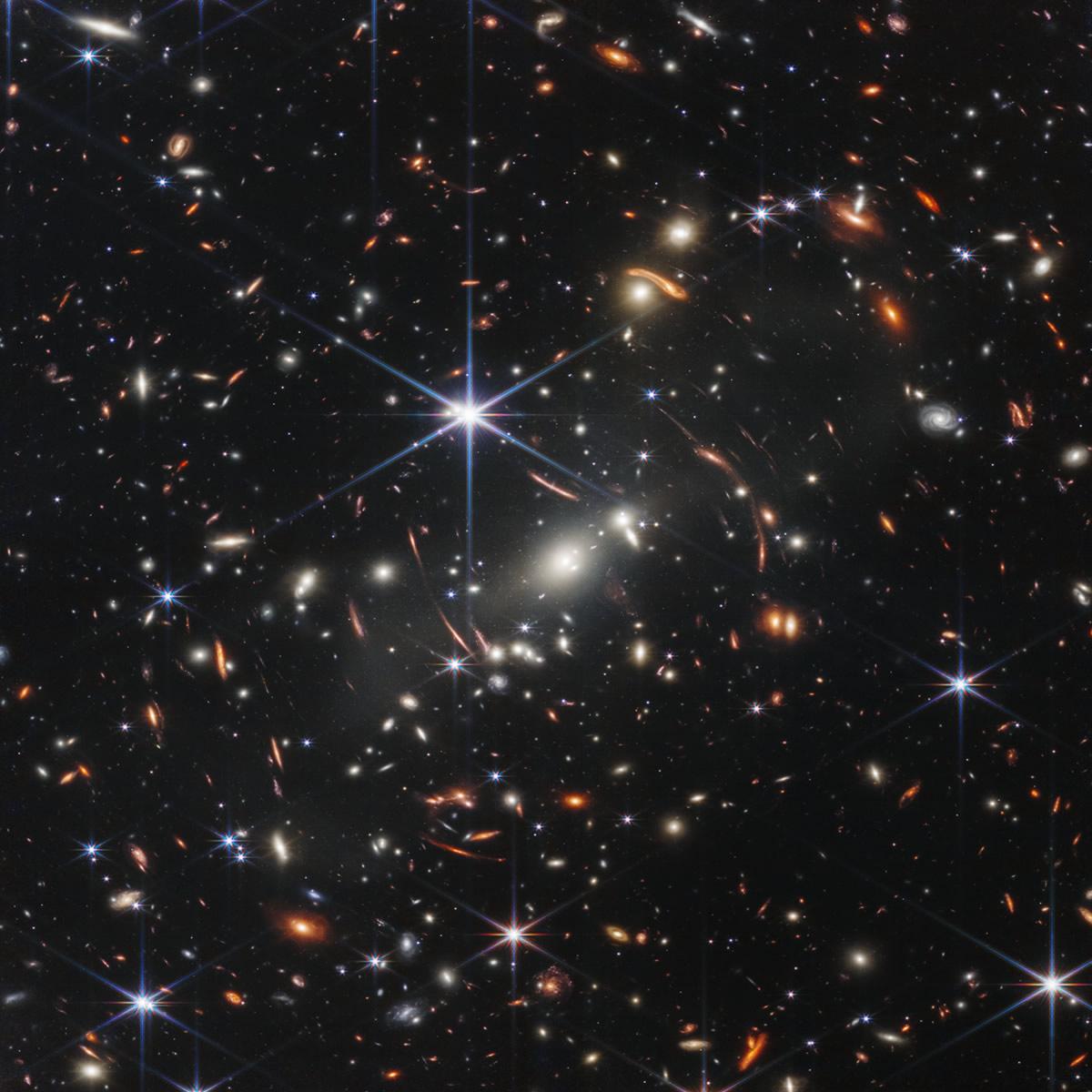(NASA photo)
Recently, NASA images from the James Webb Space Telescope showing the swirling patterns and pleasing colors of distant galaxies lit up social media and ignited the fancy of many of a viewer. And while these aesthetics are part of the appeal of the project, SUNY Oswego physics professor Shashi Kanbur notes that the telescope will tell astrophysics researchers like him much more than has been previously attainable.
"The JW telescope will be able to see the very first stars and galaxies that formed," said Kanbur, for whom studying the age and formation of the universe is a decades-long passion that has involved many publications and international research opportunities. "We can then compare these early galaxies with galaxies that formed later and understand how galaxies form."
Launched on Christmas Day in 2021, the telescope -- a partnership between NASA and the European Space Agency and Canadian Space Agency -- brings the advantages of powerful technology and proximity together to benefit researchers and everyday space fans alike by essentially looking further into the universe and into the past than ever before. The above image, the first released, "shows the galaxy cluster SMACS 0723 as it appeared 4.6 billion years ago, with many more galaxies in front of and behind the cluster," NASA explained on the telescope's website.
"Because the telescope is in space, it isn't affected by the significant blurring effect that can occur for ground-based telescopes due to the Earth's atmosphere," Kanbur explained.
In this way, it can better differentiate objects in space; for example it can better tell if a blob of light is actually multiple blobs of light, or distant suns or other objects.
"Further it is tuned to observe in the infrared, which means there will be less interstellar reddening: interstellar reddening occurs because when light travels through space it interacts with intervening dust particles which make it look redder than it actually is," Kanbur said. "But this effect is reduced at infrared wavelengths. This allows it to observe objects that would be too distant, too faint or too old for the previous space telescope (Hubble Space Telescope). It has 18 hexagonal mirror elements which combine to effectively form a 6.5-meter diameter mirror -- this is bigger than the previous space telescope."
For comparison, Kanbur recommended the Webb Compare website which shows how much clearer and defined the new telescope's images are than its predecessor.
"The JW telescope will be able to see the very first stars and galaxies that formed," said Kanbur, for whom studying the age and formation of the universe is a decades-long passion that has involved many publications and international research opportunities. "We can then compare these early galaxies with galaxies that formed later and understand how galaxies form."
Launched on Christmas Day in 2021, the telescope -- a partnership between NASA and the European Space Agency and Canadian Space Agency -- brings the advantages of powerful technology and proximity together to benefit researchers and everyday space fans alike by essentially looking further into the universe and into the past than ever before. The above image, the first released, "shows the galaxy cluster SMACS 0723 as it appeared 4.6 billion years ago, with many more galaxies in front of and behind the cluster," NASA explained on the telescope's website.
"Because the telescope is in space, it isn't affected by the significant blurring effect that can occur for ground-based telescopes due to the Earth's atmosphere," Kanbur explained.
In this way, it can better differentiate objects in space; for example it can better tell if a blob of light is actually multiple blobs of light, or distant suns or other objects.
"Further it is tuned to observe in the infrared, which means there will be less interstellar reddening: interstellar reddening occurs because when light travels through space it interacts with intervening dust particles which make it look redder than it actually is," Kanbur said. "But this effect is reduced at infrared wavelengths. This allows it to observe objects that would be too distant, too faint or too old for the previous space telescope (Hubble Space Telescope). It has 18 hexagonal mirror elements which combine to effectively form a 6.5-meter diameter mirror -- this is bigger than the previous space telescope."
For comparison, Kanbur recommended the Webb Compare website which shows how much clearer and defined the new telescope's images are than its predecessor.
Deeper exploration
This larger mirror and its sensitivity to infrared will allow observers to see much further into the universe, Kanbur said.
"Because of the finite speed of light, seeing further means seeing further back in time," Kanbur noted. "Observing pulsating variable stars called Cepheids and supernovae in distant galaxies will enable us to estimate Hubble's constant to unprecedented accuracy. This will in turn allow us to determine the eventual fate of the universe and allow us to constrain models describing the formation of the universe."
Cepheids and pulsating stars are subjects Kanbur has studied intensely for years, which has resulted in international collaborations, publications and research opportunities for SUNY Oswego students. For example, Kanbur and physics majors Selim Kalici, Michele Manno and Hugh Riley Randall this summer have worked with some of the world's top astrophysics researchers at the Max Planck Institute for Astrophysics in Germany, where Earl Bellinger -- a SUNY Oswego graduate and former student of Kanbur's -- is a post-doctoral fellow.
In addition, the Webb Telescope is just beginning to probe the question of whether life exists elsewhere.
"Because of its infrared capability, we will be able to see into the gas clouds where stars form and thus understand more about the birth of stars," Kanbur said. "We will be able to detect planets around stars like our sun and see if those planets contain life. Already the telescope has detected signs of water in the atmosphere of some extra-solar planets."
The ongoing search for knowledge, striving for answers and solving some of humanity's constant questions makes the process worthwhile, he added.
"For me the search for knowledge is enough," Kanbur said. "I don't think there can be many more important questions than constraining the formation of the universe or the formation of galaxies or the formation of stars or whether there is extra-solar life."
For more information and images, visit NASA's James Webb Telescope website.

Physics professor Shashi Kanbur has researched questions on the age and formation of the universe for decades.




